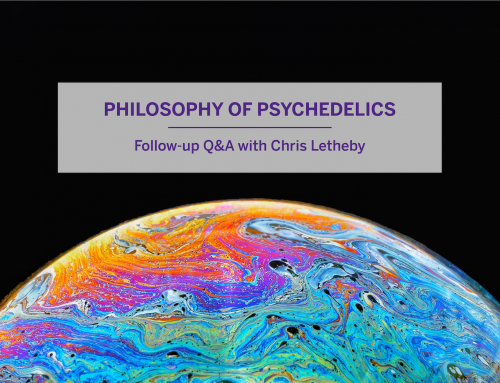By Martin Vezér
Since 2001, the Institute Vienna Circle (IVC), the University of Vienna, and the Center for Interdisciplinary Research have held a summer university program focusing on topics in the philosophy of natural and social sciences. This past July, I attended the Vienna International Summer University (VISU)—a program that brought together an international group of professors and graduate students for a two-week course on climate studies. Each day during these weeks, we met to discuss a set of readings on the science, history, philosophy and sociology of climate science In this post, I will describe some of my experiences at the 2013 VISU.

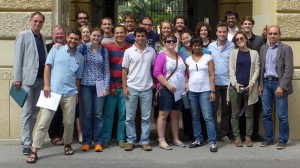
- In archway of the Kapelle building at the university of Vienna (12 July 2013 from left to right: Professor Fredrich Stalder, Professor Jim Fleming, Sam Kigar, Professor Sabine Koch, Sebastian Kletzl, Carolyn Branecky, Jakub Motrenko, Rodolfo Hernandes, Greg Lusk, Matt Panhans, Laszlo Kosolosky, Kimberly Brumble, Martin Vezér, Anna Barbosa, Professor Wendy Parker, Umberto Sconfienza, Professor Roman Frigg, Marina Pacchetti, Martin Strauss. (Photo courtesy of Marina Pacchetti)
In the classroom
The original Vienna Circle, which flourished in the city during the 1930s and 40s, demonstrated how collaborative research among scholars trained in different disciplines can be a fruitful way of studying current topics in the history and philosophy of science. Carrying on this tradition, the IVC promotes an interdisciplinary approach to addressing important philosophical questions of our time. Hosting our professors and group of graduate students, Professor Friedrich Stadler, Professor Karoly Kokai and their colleagues organized two weeks of classes as well as several historical, cultural and scientific field-trips. Lecturing and leading the classroom discussions were three scholars with expertise at junctures of the natural sciences and humanities: Professor James (Jim) Fleming, Professor Roman Frigg, and Professor Wendy Parker.
One of the advantages of the VISU approach to dealing with current topics in philosophy is the diversity of perspectives the students bring to the program. This year, the class had students from Austria, Belgium, Brazil, Canada, China, Columbia, France, India, Italy, Poland, Russia and the United States. They came with backgrounds in experimental physics, glaciology, history, education, philosophy, psychology, economics, and religious studies. This interdisciplinary mix proved to be a positive way to broaden our views about the ways in which climatic changes relate to nature, society and the human condition.
Historical perspectives on climate change
Professor Fleming presented several scenarios regarding important phases in the history of climate science. His “STOMP” method of historiography focuses on Societal needs; Tools, techniques, technologies; Observations; Models; and People. By accounting for these facets of scientific progress, he explained how we can expand our understanding of the innumerable historical factors that contribute to the development of scientific knowledge.
Societal needs. In many ways, social concerns have motivated climate research. From our Palaeolithic ancestors’ appreciation of seasonal influences on hunting and gathering, to modern programs of health care, infrastructure planning, and military strategy, knowledge about climate systems is crucial to human survival and sustainable societies.
Tools, techniques and technologies. Scientists have developed an array of methods for generating knowledge about the climate. From the methods of the Old Farmer’s Almanac to sophisticated computer simulations, climate science incorporates data, models and theories from an increasingly expansive collection of sources.
Observations. Our species has expanded its ability to detect weather and climate phenomena from a view of the sky above the horizon to high-resolution monitoring of complex earth systems. We are now able to detect previously imperceptible states of affairs, including changes in the concentrations of different molecules in the air, water and soil.
Models. Scientists have improved representations of climate and weather systems. These representations have evolved from two dimensional maps upon which scientists pencilled in information, to ensembles of numerical simulations that incorporate physical principles, estimates of initial conditions and observations of air temperature, pressure, humidity, and a host of other variables to calculate trajectories of weather and climate parameters.
People. The list of people who have set the course of climate science is far too long to enumerate, but it would include people such as Arrhenius, Tyndall, Milanković, Callendar, Keeling, and Revelle. These researchers and many others contributed to the science in different ways, such as by designing experiments to test the thermal properties of atmospheric gases, and developing numerical models of interacting earth systems. They have discovered novel ways of generating knowledge about the physical processes comprising our lands, oceans, and atmosphere.
- Professor Fleming lecturing on the history of climate science. (02 July 2013)
Models, measurement and the construction of global climate datasets
Professor Parker addressed several interesting aspects of climate science related to global observational data. She examined examples of how to deal with the spatial and temporal gaps in data-sets. On the one hand, the Met-CRU method is to calculate global temperature anomalies by using only grid points where observations were made nearby in a given month. The GISS method, on the other hand, assumes anomalies are ‘coherent’ up to 1,200km from observation stations, so that values can be assigned to grid-points rather far from sites where observations were made. This difference in methodology can lead to slightly different results when it comes to accounting for global temperature anomalies. Yet another method involves combining traditional observations with simulation results. Comparing these various methods raises several interesting epistemic issues. It illustrates how global climate datasets can be attained in different ways when combining heterogeneous, unevenly distributed data. It also exemplifies how some ‘observational’ data commonly used in weather and climate modelling are derived from simulations as well as observations of the target system. Further, it demonstrates how the generation of climate records is an ongoing process, open to revision according to improved measurement, modelling and reanalysis techniques. Accordingly, two questions Professor Parker is pursuing in this regard are: (1) Can reanalysis results for some variables be classified as ‘observations’ or perhaps ‘measurements’ of atmospheric properties even though they are in fact simulation output? (2) Can data assimilation be placed on a spectrum with other measuring procedures (which also often rely on models of various sorts)?
Downscaling Projections from General Circulation Models
Professor Frigg discussed climate modellers’ efforts to produce plausible local-scale climate projections by incorporating information from large-scale regional or global projections. In order to inform local adaptation strategies, some climate modelling research programs, such as UKCP09, provide comparatively high-resolution projections out to the end of the 21st century. Uncertainties about large-scale projections are, however, amplified when one interprets what these projections suggest about conditions at the smaller scales relevant for many local adaptation strategies. In the case of UKCP09, modellers generate end-of-century projections at grid-sizes of about 25km on the basis of models that have a grid-size of about 300km. Professor Frigg argues that such an approach to non-linear modelling of chaotic systems is problematic because many of these models are structurally unstable: “if a non-linear model has the slightest structural error,” he explains, “then its ability to generate useful prediction is lost. Since we don’t have a perfect model of the climate, this is a serious problem. There is no reason to assume that the climate system will behave similar to our model, even if the model is close (in some relevant sense) to the real system.” According to this account, uncertainties inherent in large-scale global circulation models is too great to permit the kinds of local scale projections required to inform local adaptation strategies.
He also noted that policy-makers typically can and do make all sorts of decisions (including those pertaining to long-term adaptation planning) under conditions of uncertainty. To demand some decision-relevant probability density function for the effects of climate change is to raise the standards of evidence-based policy to an unreasonably high level. Instead, we can develop public policy, appreciating multiple sources of evidence related to a hypothesis and weighing the policy options available. (Professor Frigg and colleagues have a forthcoming publication on this topic in Philosophy of Science.)
Moral Problems of Climate Change
Moving from questions about the epistemology of climate science to moral ones about the ethics of human-induced climate change, our guest lecturer, Professor Angela Kallhoff, provided the class with an overview of several relevant approaches to studying questions of social justice in the context of climate change. As a global public good, the atmosphere envelopes political borders of modern nation states such that the actions of people at one side of the globe can affect the well-being of people and ecosystems a great distance away. Further, these effects can take place years, decades or millennia after those actions occurred. How, then, might one attribute moral responsibility for the effects of a climatic change to a given group of people? Even with the knowledge that most of the global warming since the mid-20th century is due to actions of industrialized societies, a generational gap exists between those involved in activities leading to the current warming and those who experience its effects. By carefully examining several notions of equity, distributive justice and compensatory justice, Professor Kallhoff’s research aims to find solutions to these philosophic problems, which may also inform the practical ones of environmental policy.
Around the City
Another major attraction of VISU is, of course, the city of Vienna. Located along the Danube Corridor, it is rich in human history, with humans taking root in the area during the Palaeolithic Era. Evidence of continuous settlements along this part of central Europe survives from the time of the Celts (c. 500 BCE). The landscape of Vienna still echoes activities of the Romans who, in first century CE developed a military camp, which still shapes the core of the city. Today, the museums of Vienna contain troves of art and artefacts from these times, through the Medieval and Baroque periods, on to the modern age. A similarly impressive span of historic genres is evident in the city’s infrastructure, architecture, and parks.
Led by faculty and recent doctoral graduates of the University of Vienna, our group visited several cafes, restaurants, and historic sites. One day prior to the commencement of classes, Dr. Bernhard (Berny) Beham gave us a guided tour of the old city. Our meeting point was one of Vienna’s most distinctive landmarks, Stephansdom (aka St Stephen’s Cathedral), a Gothic cathedral with foundations dating back to 1147 CE. From there, we set out to explore other parts of the city, visiting some of the local shops, markets, cafes, monuments and other attractions, ending the tour with some traditional Viennese delicacies and wine spritzers.
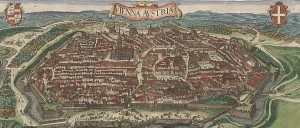
Panoramic view of Vienna after the city walls were reconstructed in 1548. In the middle is Stephansdom, behind the medieval Hofburg complex. Right next to it is the Minoritenkirche and to the far right Schottenstift with the Schottentor gate. (Image Source: Wikipedia)
Professor Sabine Koch and Dr. Christoph Limbeck-Lilienau organized and led our second tour, which focused on the history and architecture of the University of Vienna and other neighbourhoods of the city. Founded in 1365, the University of Vienna is the oldest university in the German-speaking world and currently one of the largest universities in central Europe. In the arcades of the university and around the city, sculptures memorialize Viennese scholars influential in the history of philosophy of science, including Mach, Boltzmann, Freud, Popper, and others.
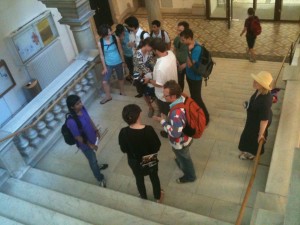
Professor Koch (in right of photo) and Dr. Limbeck-Lilienau (with red backpack) show VISU members a memorial to Vienna Circle founder, Moritz Schlick, who was killed on that spot by a deranged student on 22 June 1936. (3 July 2013)
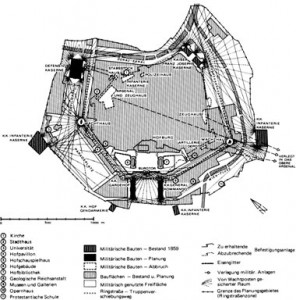
Designed before 1860s, during the reign of Emperor Ferdinand I of Austria, the military plan above depicts the Ringstrasse, a residential zone of the Habsburgs and other noble families. Cross-sectioning lines provide lines of sight down streets of the area, allowing soldiers to take aim towards all corners of the compound. Some interpret this design as illustrative of the distrust the Habsburgs held towards the university of the time. Inspired by activities in France, ideas of enlightenment and revolution, Viennese intellectuals published pamphlets and newspapers discussing education, language, and a desire for liberal reforms.
(Image courtesy of Professor Koch)
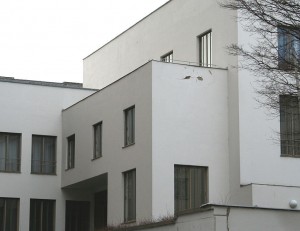
A house philosopher Ludwig Wittgenstein designed for his sister, Margaret. Planned and build between 1925 and 1928, the building embodied the austerity of Wittgenstein’s early philosophy. Wittgenstein insisted on custom quarry tiles, metal curtains that retracted into the floors, minimal door hardware, the complete exclusion of curtains, lamp covers and fabrics of any kind, and a garden that could only have green vegetation, without any colourful flowers. “I am not interested in erecting a building,” Wittgenstein explained, “but in … presenting to myself the foundations of all possible buildings” (quoted in Hide, 2008). (Photo source: Wikipedia)
Our third group excursion was a tour of The Central Institute for Meteorology and Geodynamics (Zentralanstalt für Meteorologie und Geodynamik or ZAMG). There, ZAMG meteorologist, Verena Hirss, showed us a collection of their earth-systems technology, including antique instruments such as a hair tension hygrometer, a seismometer from 1905, as well as modern instruments such as their forecasting computers and a weather balloon which, as a live demonstration, they launched, tracked and used to collect data. She also introduced us to other ZAMG staff who described their meteorology, climatology and seismology projects. After the tour, two ZAMG experts, Dr. Christa Hammerl and Dr. Christoph Matulla lectured on the history of ZAMG and the evolution of their regional climate modelling program.
- In front of the Julius Hann Haus building at ZAMG, from left to right: Professor Sabine Koch, Bastian Stoppelkamp, Dimitri Putilin, Rodolfo Hernandez, Miral Shah, Jakub Motrenko, Laszlo Kosolosky, Marina Pacchetti, Matt Panhans, Professor Wendy Parker, Dr. Christoph Matulla, Dehlia Hannah, Kimberly Brumble, Professor Roman Frigg, Professor Jim Flemming, Dr. Micael Staudinger, Professor Karoly Kokai, Dr. Christa Hammerl, Martin Vezér, Professor Fredrich Stalder. (Photo courtesy of ZMAG blog.)
The combination of the VISU course and our extracurricular activities made for an inspiring and memorable experience. It provided me with an opportunity to collaborate with a diverse group of scholars interested in addressing a complex set of questions related to climate change. I returned to Canada with a deeper appreciation of how other international scholars approach the complex subject of climate studies, some personal insights on the city of Vienna, and a new network of friends and colleagues working in fields related to my own area of study.
The VISU 2014 program is ‘Humans/Animals: A Contested Boundary.’ If this topic interests you, I would highly recommend you apply to the program.
_____________________________________________
Martin Vezér, a PhD candidate in the Department of Philosophy at Western University (London, Ontario, Canada), is a resident member of the Rotman Institute of Philosophy.

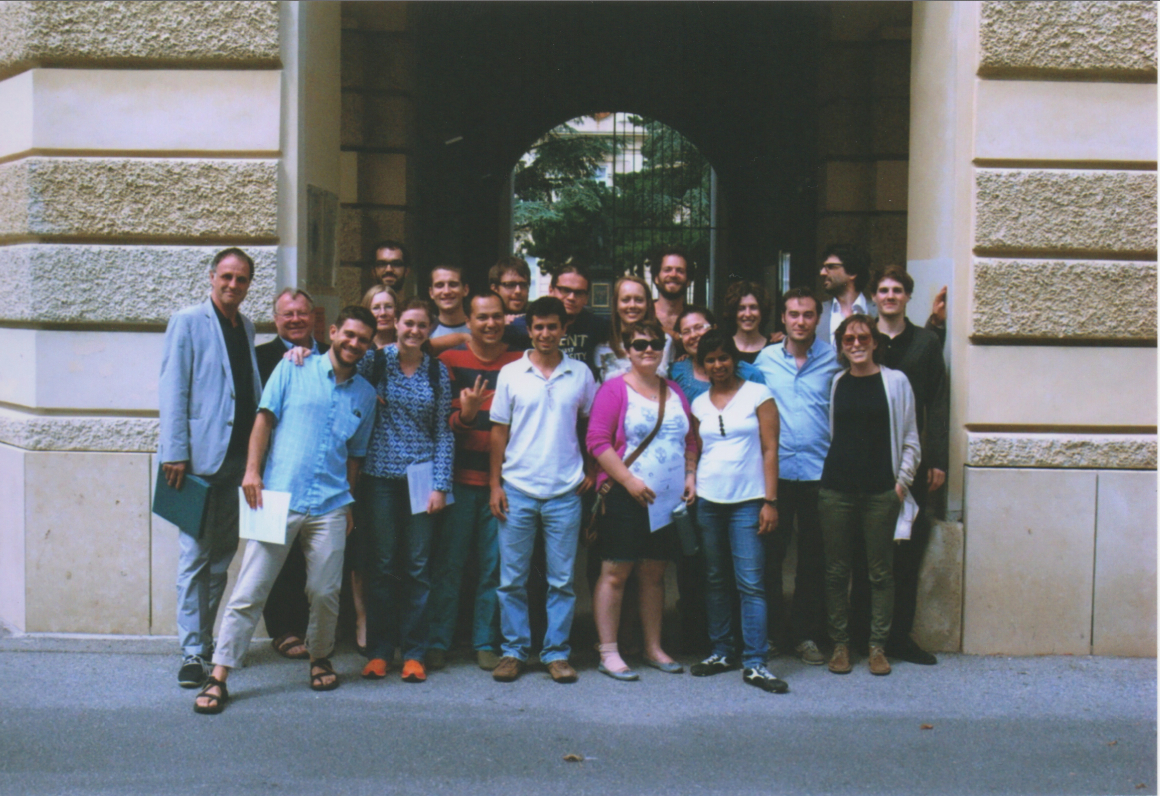

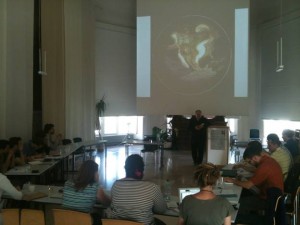
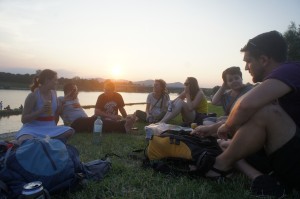

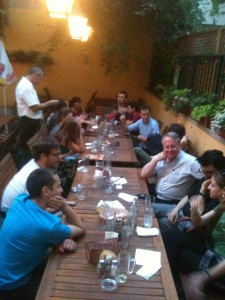
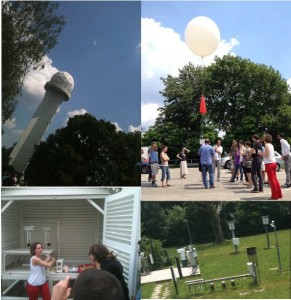
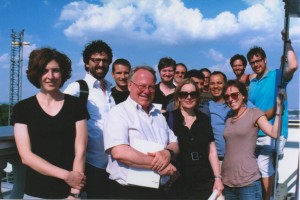
![In front of the Julius Hann Haus building at ZAMG, from left to right: Professor Sabine Koch, Bastian Stoppelkamp, Dimitri Putilin, Rodolfo Hernandez, Miral Shah, Jakub Motrenko, Laszlo Kosolosky, Marina Pacchetti, Matt Panhans, Professor Wendy Parker, Dr. Christoph Matulla, Dehlia Hannah, Kimberly Brumble, Professor Roman Frigg, Professor Jim Flemming, Dr. Micael Staudinger, Professor Karoly Kokai, Dr. Christa Hammerl, Martin Vezér, Professor Fredrich Stalder. (Photo courtesy of ZMAG blog.)]](http://www.rotman.uwo.ca/wp-content/uploads/MV.20130710_VISU1-300x224.jpg)

